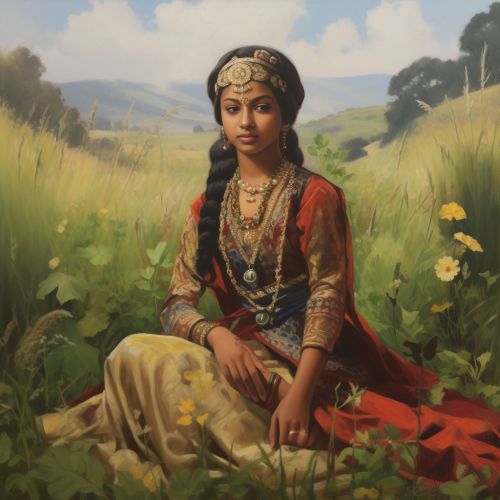Sita
Introduction
Sita, also known as Sītāmāyā or Janaki, is a central figure in the Hindu epic Ramayana. She is the consort of the Hindu god Rama and is an avatar of Lakshmi, the goddess of wealth and wife of Vishnu. Sita is revered for her dedication, self-sacrifice, courage and purity.
Etymology and other names
The name Sita means "furrow" in Sanskrit, signifying her divine origin from the earth. She is also known as Janaki as the daughter of King Janaka and Maithili as the princess of Mithila. Her other names include Vaidehi, Bhumija, and Ramaa.
Birth and childhood
According to the Ramayana, Sita was discovered in a furrow in a ploughed field, and for that reason is regarded as a daughter of Bhūmi Devi, the goddess of the Earth. She was discovered by King Janaka, who was ploughing the field as a part of a yajna, a sacrificial ritual.


Marriage to Rama
Sita's marriage to Rama, the prince of Ayodhya, is a central part of the narrative. The story of their marriage is detailed in the Bala Kanda of the Ramayana. Rama won Sita's hand in marriage by successfully stringing and breaking the divine bow of Shiva, a task deemed impossible for ordinary mortals.
Exile and abduction
Sita accompanied Rama during his 14-year-long exile in the forest. During this period, she was abducted by the demon king Ravana and taken to Lanka. This event led to the epic war between Rama and Ravana, known as the Rama-Ravana Yudh.
Trial by Fire
After the defeat of Ravana, Sita was rescued. However, to prove her chastity, she underwent the Agni Pariksha (Trial by Fire). She entered a blazing fire but was unharmed, proving her purity and innocence.
Later life and disappearance
After returning to Ayodhya, Sita was once again put to the test due to gossip and slander among the kingdom's subjects. She chose to leave the kingdom and sought refuge in the hermitage of Sage Valmiki, where she gave birth to her twin sons, Lava and Kusha. Sita disappeared into the earth, her mother, after fulfilling her purpose on Earth.
Legacy
Sita's character and her story have had a profound influence on art, culture, and women's role in society in the Indian subcontinent. She is revered as an ideal of womanhood and wifely devotion. Her trials and tribulations have been depicted in various forms of art and literature.
